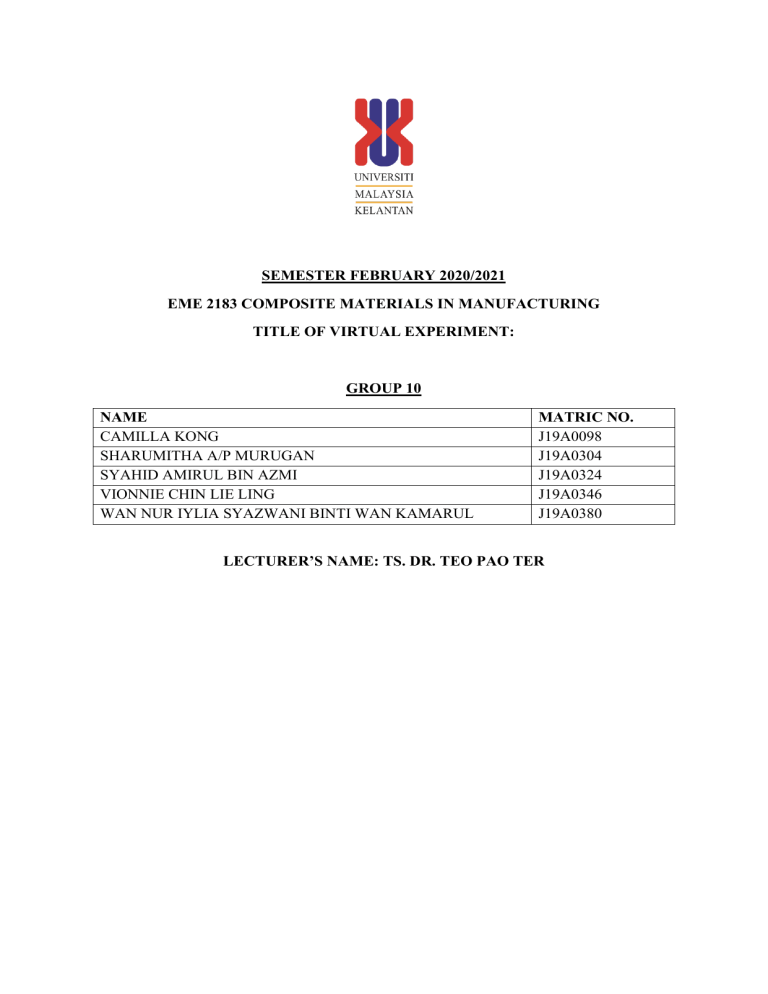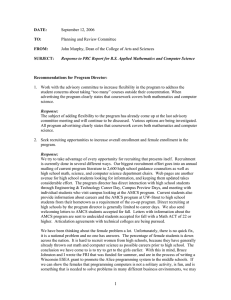
SEMESTER FEBRUARY 2020/2021
EME 2183 COMPOSITE MATERIALS IN MANUFACTURING
TITLE OF VIRTUAL EXPERIMENT:
GROUP 10
NAME
CAMILLA KONG
SHARUMITHA A/P MURUGAN
SYAHID AMIRUL BIN AZMI
VIONNIE CHIN LIE LING
WAN NUR IYLIA SYAZWANI BINTI WAN KAMARUL
MATRIC NO.
J19A0098
J19A0304
J19A0324
J19A0346
J19A0380
LECTURER’S NAME: TS. DR. TEO PAO TER
ABSTRACT.
Aluminum matrix composites (AMCs) is classified as a lightweight, high-power
aluminum-centric material system. Sustainable or discontinuous fibers, whiskers, or particles
could be used as reinforcement materials in the fabrication of AMCs at volume fractions
ranging from a small percentage to 70%. By using a suitable combination of matrix,
reinforcements, and processing route, AMC properties can be adapted to the requirements of
various industrial applications. Currently several AMC grades are produced through different
routes. A variety of applications are associated with aluminum matrix composites (AMCs) and
it plays a significant role in many industrial and engineering applications, such as the
automobile and aerospace industries. AMCs are fabricated from aluminum as the matrix, and
hard ceramic or other metals as its reinforcements. The objective of this experimental study is
to fabricate the Al2O3-TiC-reinforced AMC, and to study the effect of additional
reinforcements and the wt.% of the reinforcements on the mechanical properties of the AMCS.
In this case, the contents of Al2O3-TiC reinforcements in the aluminum matrix vary in
compositions, with an aluminum casting technique (0, 5, 10, 15, 20 wt.%). Reinforced AMCs
have been found to be superior to non-reinforced aluminum. The strengthened properties of
AMCs include the tensile strength, hardness, and wear strength. In the process of developing
lightweight aerospace components, the current composite proves to be useful in this
application.
INTRODUCTION.
Materials play an important role in our life because of the ever-changing manufacturing
scenario which has been deep-seated in our life. The manufacturing system, daily needs,
communication, and transportation has been depending on different materials technology to
continue its operation. Therefore, the technology of materials has been improving in every
aspect to suit the applications and human needs, with the development of new kinds of
materials to produce components that are stronger and at the same time lighter in terms of
weight. To achieve the aim of producing a strong but lightweight material, composite materials
have been introduced into the world since as early as the 1500 BC by the early Egyptians and
Mesopotamians. Composite materials are commonly used in the production of cutting tools,
seal rings, bearing parts, and different engine parts that are required to work under high
temperatures. Composite materials have always been popular because they possess better
mechanical properties, and they are suitable for a wide range of application. Based on past
research, it was found that composite materials are more advanced when the reinforcements
are dispersed into the matrix in either a continuous or discontinuous phase.
Aluminum metal matrix composites are one of the major research areas for the
development of lightweight materials in the 21st century. This is because aluminum metal
matrix composites have a wide range of applications, especially in the automobile industries
and in the aerospace industries. Aluminum metal matrix composite is a type of composite
material where aluminum is reinforced with other metals, organic compound, or ceramics by
dispersing the reinforcement into the aluminum which act as the matrix. The reinforcement of
aluminum matrix composites (AMCs) can be in any form depending on the applications, such
as particulates, continuous or discontinuous fibers, and whickers form. Aluminum metal matrix
composites can be categorized into four types based on their reinforcements, which are particlereinforced AMCs, continuous fiber-reinforced AMCs, short fiber or whiskers-reinforced
AMCs, and monofilament-reinforced AMCs. According to studies by Dong Q. et. al (2004)
and Lindroos VK. and Talvitie MJ. (1995), it was stated that the reinforcements used in metal
matrix composites should be non-reactive and stable in the given working temperature.
Aluminium metal matrix composites have been synthesized and characterized and used
in various kinds of engineering applications to gain a better combination of mechanical
properties. The benefits of using aluminium matrix composites are the density of materials can
be reduced, but also possesses greater strength, greater thermal stability, higher abrasion
resistance, better wear resistance, and greater damping properties. Therefore, to fabricate
composite materials that has better mechanical properties such as greater tensile strength, high
hardness and improved wear resistance, reinforcement materials such as SiC, B4C, and Al2O3
ceramics are dispersed into aluminium matrix. Various processing methods can be used to
fabricate aluminium matrix composite such as the stir casting, infiltration, squeeze casting,
powder metallurgy, and semisolid processing techniques. In our experimental study, we will
discuss about the effect of adding Al2O3-TiC reinforcements into the aluminium matrix on the
tensile strength, hardness, and wear resistance of the composite.
EXPERIMENTAL FLOW CHART.
Al2O3-TiCreinforced AMC
was fabricated by
stir casting.
TiC particles were
added to the furnace
using a funnel and then
heated for 30 minutes.
The mixture was
mixed again before
pouring it into the
SC mould, then the
melt was poured,
letting it solidify at
room temperature.
Five different
reinforcement
formulations were
used to make five
composites’ samples.
The experiment
was conducted in a
temperaturecontrolled furnace
with a maximum of
1200°C.
Heat-treated Al2O3
particles were
introduced into the
furnace then heated
for 20 minutes and
stirred for 5
minutes.
Al-1100 ingots were
melted in a furnace
for 30 minutes, and
then the melted
aluminum was stirred
for 3 minutes.
Lastly, to avoid
casting defects, the
upper side of the
mould was covered
with a board.
MATERIALS.
Aluminum-1100 alloy, Alumina TiC particles
APPARATUS.
Stir casting mould (SC mould) and furnace.
EXPERIMENTAL PROCEDURE.
1. The stir casting method was used to fabricate Al2O3-TiC-reinforced aluminium matrix
composites.
2. Five AMC samples were fabricated with five different reinforcement formulations.
3. The experiment was carried out in a controlled furnace with a maximum temperature
of 1200°C.
4. Al-1100 ingots were melted at 950°C in a furnace for 30 minutes before the melted
aluminium was stirred at 400 rpm for 3 minutes.
5. The heat-treated Al2O3 particles was added into the furnace through a funnel at 950°C
then it was heated for 20 minutes at 1070°C, and stirred for 5 minutes at 1070°C.
6. With the support of a funnel, TiC particles were added into the furnace at 1070°C before
being heated to 1150°C for 30 minutes.
7. The mixture was mixed once more before pouring into the stir casting mould.
8. The melt was poured into the stir casting mould and was left to solidify at room
temperature.
9. The upper side of the mould was sealed with a sheet to prevent casting defects.
10. The solidified AMC samples were subjected to Rockwell hardness testing, tensile
testing, and wear testing, and the results of the respected testing were recorded and
analysed.
EXPECTED RESULTS & DISCUSSION.
The fabrication and characterization of Al2O3-TiC-reinforced aluminium matrix
composite (AMC) was studied. The effect of the reinforcements on the mechanical properties
of the AMC samples was put to test. The mechanical properties of the AMC samples that were
tested in this experimental study include the hardness, tensile strength, and wear resistance.
Hardness refers to the ability of a material to resist deformation when a certain force is applied
to it. The hardness property of a material is usually measured by the material surface resistance
to indentation. Tensile strength refers to the maximum load that a material can withstand when
it is being stretched without fracture or deformation. Wear resistance refers to the ability of a
material to resist the aggressiveness of a wearing medium.
From this experimental study, we found that with the addition of reinforcements in the
aluminium matrix, it has increased the hardness property of the AMCs. This statement was
proven through the mechanical testing procedure of applying a minor load of 10 kg and a major
load of 90 kg onto the AMC samples. The mechanical testing procedure is known as the
Rockwell hardness testing. Since different weight percentage (wt.%) of reinforcements were
added to different AMC samples, we also learned from the results obtained from the Rockwell
hardness testing that, the different wt.% of reinforcements added to the AMC samples also
significantly affect the hardness property. The results shows that the increase in wt.% of
reinforcements in the AMCs have further increased the hardness property of the AMCs. The
reinforcement particles used in the fabrication of the AMCs act as a strengthening agent that
can help to create a stronger bond between the particles in the AMCs, which is the explanation
for the improved mechanical properties of the AMCs. The hardness of the aluminium matrix
was improved by preventing the dislocation movements in the AMCs with the presence of well
bonded and harder Al2O3-TiC reinforcement particles in the aluminium matrix.
Other than that, we also learned from this experimental study that the tensile strength
of the aluminium matrix has also significantly improved with the addition of reinforcements in
the aluminium matrix. The results proved that reinforced AMCs have higher tensile strength
compared to the unreinforced aluminium. The mechanical testing used to inspect the tensile
strength of the AMCs is known as the tensile testing. We also learned from the results obtained
from the tensile testing carried out on the different AMC samples with different wt.% of
reinforcements added that, the increase in wt.% of reinforcements in the AMCs have further
increased the tensile strength of the AMCs. The increase in tensile strength of the AMCs is the
result of strong interfacial bonding between the aluminium matrix and the Al2O3-TiC
reinforcements. Applied load in the AMCs were transferred to the strong bonded
reinforcements in the aluminium matrix, which is the explanation for an increase in tensile
strength of the AMCs. The results of the Rockwell hardness testing and tensile testing have
also coincided with the mechanical properties theory of metal where it is stated that with the
increase in hardness property of the metal, the tensile strength of the metal will also
significantly increase.
The wear resistance of the AMC samples was tested using the wear testing procedure
which was performed at 300 revolutions per minute grinding speed for a fixed amount of time,
and a constant load of 10 Newton was also applied to the AMC samples during the wear testing
procedures. The wear resistance of the AMCs was determined from the mass loss of the AMCs
after being subjected to the wear testing. From the experimental results obtained in this
experimental study, we found that the wear resistance of the reinforced AMCs has significantly
improved compared to the unreinforced aluminium. The results obtained from the wear testing
shows the decrease in mass loss of the samples with an increased wt.% of reinforcements
proves that, the increase in wt.% of reinforcements have further enhanced the wear resistance
of the AMCs. The wear resistance of the aluminium matrix was enhanced with the addition of
TiC particles. This is because, when subjected to wear testing, pure aluminium matrix from the
surface of the AMCs will be worn out first, which leaves the Al2O3-TiC particles on the surface
of the material. The reinforcements which were exposed on the surface of the AMCs protects
the aluminium matrix from further wear. During the experimental study, it was also found that
the most influencing parameter which affects the wear rate of the AMCs is the sliding distance
compared to the applied load and sliding speed.
CONCLUSION.
Aluminium matrix composites (AMCs) were prepared in this experimental study, with
varied wt.% of the Al2O3-TiC reinforcements content by stir casting fabrication method. The
fabricated AMC samples were then subjected to the Rockwell hardness testing, tensile testing,
and wear testing to determine the effect of varied wt.% of reinforcements on the hardness,
tensile strength, and wear resistance of the AMCs. Based on the results from the experimental
study, we can conclude that by adding the Al2O3 and TiC reinforcement particles into the
aluminium matrix has increased the hardness of the AMCs and with the increased wt.% of the
reinforcements significantly improved the hardness of the AMCs. We can also conclude that
the tensile strength of the AMCs is higher in reinforced AMCs compared to the unreinforced
aluminium and AMCs with more wt.% of reinforcements possess greater tensile strength
compared to AMCs with less wt.% of reinforcements. Finally, we can also conclude from this
experimental study that the addition of the TiC reinforcement particles into the AMCs have
improved the wear resistance of the AMCs and with the increased wt.% of the reinforcements
significantly improved the wear resistances of the AMCs. This experimental study has proven
that with the addition of alumina particles and TiC particles into the aluminium matrix, we are
able to produce AMCs which possess increased tensile strength, high hardness, and improved
wear resistance compared to unreinforced aluminium.
REFERENCES.
1. Handbook-Mechanical Properties. (n.d.). ESAB.
https://www.esabna.com/euweb/oxy_handbook/589oxy8_6.htm#:%7E:text=However
%2C%20hardness%20can%20be%20measured,and%20the%20lower%20its%20ducti
lity.
2. The Editors of Encyclopaedia Britannica. (n.d.). Strength of materials | engineering
discipline. Encyclopedia Britannica. https://www.britannica.com/technology/strengthof-materials
3. The Editors of Encyclopaedia Britannica. (n.d.-b). tensile strength | Definition, Unit,
& Facts. Encyclopedia Britannica. https://www.britannica.com/science/tensilestrength
4. Wear and wear resistance - Praxis Engineering. (n.d.). Praxis Engineering.
http://www.praxis-rus.com/wear-and-wear-resistance/
5. Jamwal, A. (2019). Fabrication and Characterization of Al2O3–TiC-Reinforced
Aluminum Matr. SpringerLink. https://link.springer.com/chapter/10.1007/978-981-136412-9_33?error=cookies_not_supported&code=d7f1af59-d1e2-4b19-96dff589f31b5c44
6. Chapter 6 - Metal Matrix Composites. (n.d.). Google Books.
https://books.google.com.my/books/about/Chapter_6_Metal_Matrix_Composites.htm
l?id=bQ4nzQEACAAJ&redir_esc=y
7. Surappa, M. K. (2003, February 1). Aluminium matrix composites: Challenges and
opportunities. Sādhanā.
https://link.springer.com/article/10.1007/BF02717141?error=cookies_not_supported
&code=e75a713d-9636-48b6-956f-195bbf109e6b



